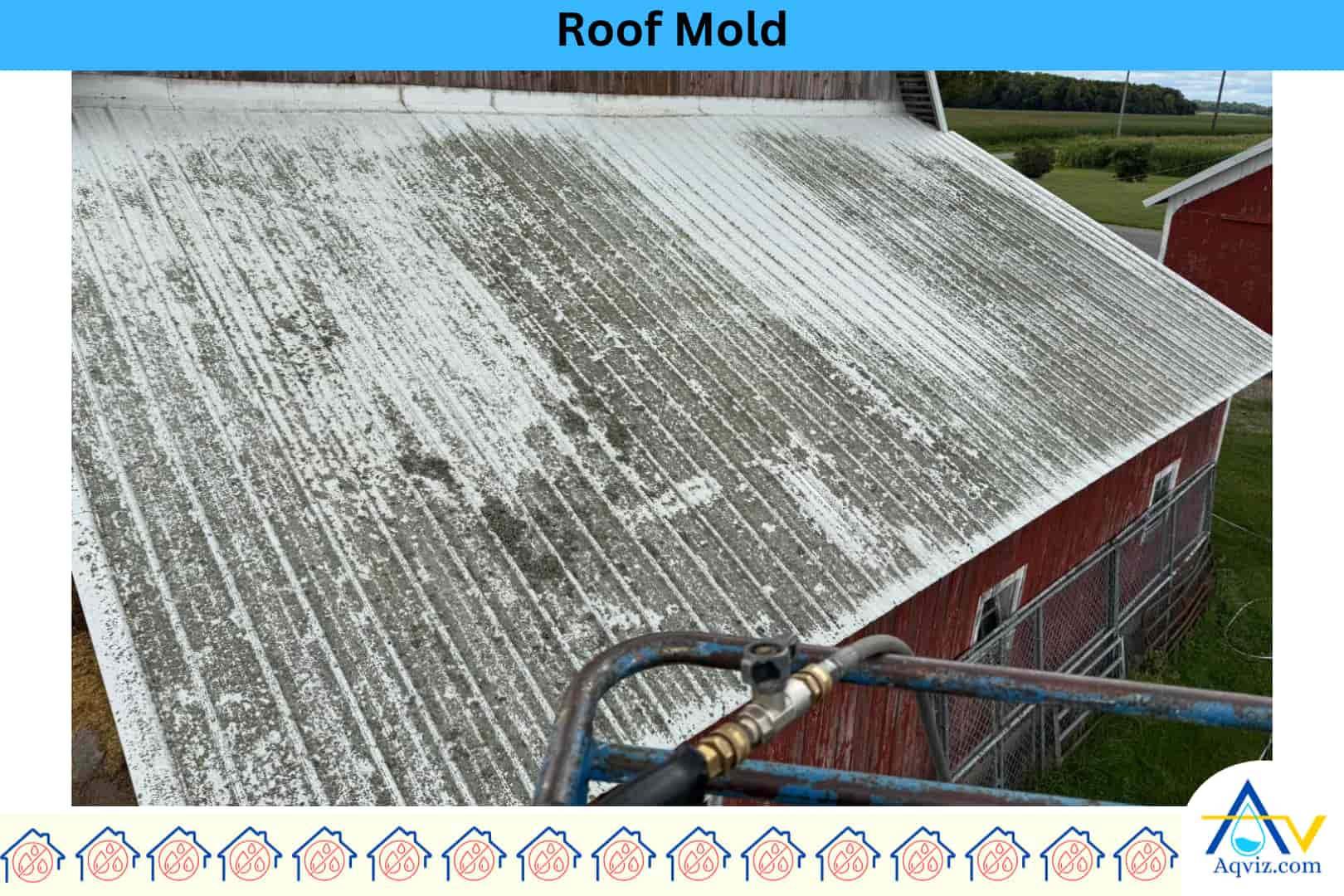Roof Mold: Signs, Reasons, Impacts and How to Fix

Roof mold is a type of fungus that forms on roofing materials. Roof mold spreads on the roof valleys, under eaves, around the chimney, beneath the skylight, near roof vents, and along the flashing edges. The 5 main reasons for the mold growth on the roof are trapped moisture under the roof surface, poor ventilation, shaded roof areas, organic debris accumulation, and roof leaks. Roof molds are in different types, and each has a unique color.
Roof types such as asphalt shingle, wood shake roof, flat roof, clay tile roof, and slate roof can be damaged by the mold due to their material composition, surface condition, and environmental conditions. When you observe discolored patches, moss or algae buildup, musty odor in the attic, ceiling stains, warped or lifted shingles, and peeling paint near eaves on the roof or parts of the roof, it can be a strong sign of mold spreading on the roof area.
Roof mold causes shingle deterioration, underlayment damage, ceiling sagging, indoor air contamination, reduces energy efficiency, and decreases the property value of the home. To prevent this, you can clean the roof mold. You can use both DIY cleaners and commercial cleaners to clean the roof mold. If you need to prevent mold growth on the roof permanently, you should improve the attic ventilation, trim overhanging trees, clean gutters, install zinc or copper strips, use mold-resistant materials, and remove the organic debris on the roof.
What Is Mold on the Roof?
Roof mold is a type of fungus that forms on roofing materials. The ideal conditions for fungal growth on roof molds are prolonged moisture, lack of sunlight, and improper airflow. Roof mold typically appears in black, green, or dark brown patches and commonly spreads across asphalt shingles, clay tiles, slate surfaces, and wooden shakes. Roof mold can be seen on roof valleys, under eaves, ridge caps, flashing edges, and areas near chimneys or skylights, where water tends to collect during rain or snowmelt.
Roof mold develops more aggressively on north-facing slopes and shaded sections, especially when organic debris like moss, pine needles, or decaying leaves accumulates. The growth of roof mold accelerates during spring and fall, when humidity levels are high and temperatures stay between 10°C to 30°C (50°F to 86°F). Persistent roof mold causes surface erosion, increases the risk of water intrusion, and leads to structural issues such as insulation damage and ceiling sagging over time.
Read More About: What to Know About Roof Waterproofing?

What Are the 5 Types of Mold on the Roof?
There are 5 common types of mold on the roof, each with unique color traits, behaviors, and preferred growth areas across roof surfaces.
- Cladosporium mold is usually black or dark green. It commonly appears around roof vents, under metal flashing, and in roof valleys where moisture is trapped after rain.
- Aspergillus mold is yellow, green, or gray and tends to grow beneath shingles, inside soffits, and along the base of chimneys where ventilation is poor.
- Stachybotrys mold , often called toxic black mold, is deep black and thrives near roof leaks, inside attic sheathing, and under water-damaged underlayment.
- Alternaria mold is brownish-gray or dark olive and typically spreads near clogged gutters, below skylights, and at the intersection of roof slopes.
- Aureobasidium mold appears pink, purple, or brown, often forming near wooden eaves, behind fascia boards, and along untreated roof trim exposed to rain and humidity.
Which Roof Types Get Damaged by Mold?
Roof types such as asphalt shingle, wood shake roof, flat roof, clay tile roof, and slate roof can be damaged by the mold due to their material composition, surface condition, and environmental conditions.
- Asphalt shingle roof: Asphalt shingle roof gets damaged by mold due to its granulated surface that traps moisture and the organic fillers in the shingles that feed fungal growth. Mold spreads quickly between overlapping layers, especially in shaded areas with poor airflow on the asphalt roof.
- Wood shake roof: Wood shake roof gets damaged by mold because the natural wood fibers absorb water and provide nutrients for mold colonies.
- Flat roof: Flat roof gets damaged by mold due to frequent water ponding and poor drainage systems that leave surfaces wet for extended periods.
- Clay tile roof: Clay tile roof gets damaged by mold when surface cracks hold moisture and organic dust collects beneath overlapping tiles.
- Slate roof: Slate roof gets damaged by mold because biological debris collects in joints and under loose tiles, especially in older roofs.
What Are the 6 Signs of Mold on the Roof?
Aqviz experts use these 6 clear signs to detect and identify mold on the roof, including discolored patches, moss or algae buildup, musty odor in the attic, ceiling stains, warped or lifted shingles, and peeling paint near eaves.
- Discolored patches: Discolored patches, often black, green, or brown, show visible evidence of mold colonies forming across shingles, tiles, or flashing on the roof.
- Moss or algae buildup: Moss or algae buildup on the roof surface can indicate underlying mold development. Homeowners should observe thick green layers that trap moisture and create ideal mold-growing conditions.
- Musty odor in the attic: Musty odor in the attic can be an early sign to detect hidden mold behind the sheathing or insulation. This mold-related smell results from fungal spores accumulating in enclosed roof spaces.
- Ceiling stains or discoloration: Ceiling stains or watermarks indoors often show mold-related leaks from the roof.
- Warped or lifted shingles: Warped or lifted shingles may indicate that mold has developed underneath the shingle layers. This mold weakens the roofing structure, especially in damp areas where adhesive bonds begin to fail.
- Peeling paint near eaves: Peeling paint near eaves and fascia boards can signal water retention caused by mold along the roof edges.
In Which Roof Areas Does Mold Cause the Most Damage?
Roof mold damages specific roof areas more severely due to frequent moisture exposure, shade, and debris accumulation. Below are the most affected areas and the reasons for roof mold growth.
- Roof valleys: Roof valleys are highly prone to mold because water naturally flows and collects in these channels. This helps organic debris like leaves and twigs, trap moisture, creating an ideal mold environment on the roof.
- Under eaves: Under eaves suffer from mold growth due to limited sunlight and poor air circulation. This results in moisture staying trapped longer, especially if gutters overflow or soffit vents are blocked on the roof.
- Around chimneys: Around chimneys is a common mold growing area because flashing joints often leak, allowing water intrusion.
- Beneath skylights: Mold forms beneath skylights when seals deteriorate or condensation collects on edges.
- Near roof vents: Near roof vents, mold appears if humid attic air escapes and condenses around vent bases.
- Along flashing edges: Along flashing edges, mold thrives where metal meets roofing material, especially if sealant fails or caulking deteriorates.
What Are the 5 Reasons for Roof Mold?
There are 5 primary reasons for roof mold, each linked to specific environmental or structural conditions that promote fungal growth on roofing surfaces.
- Trapped moisture: Trapped moisture causes for roof mold when rainwater, dew, or condensation remains on the roof surface due to poor drainage or debris accumulation.
- Poor ventilation: Poor ventilation causes roof mold by allowing humid air to build up in attic spaces. Without adequate airflow, moisture remains trapped beneath the roof deck, especially during seasonal temperature shifts.
- Shaded roof areas: Shaded roof areas cause mold because they receive little direct sunlight, slowing down drying after rain. Roof sections under trees or on north-facing slopes stay damp longer.
- Organic debris accumulation: Organic debris accumulation causes mold by holding moisture and providing nutrients like cellulose. Leaves, pine needles, and moss are common mold triggers on neglected roofs.
- Roof leaks: Roof leaks cause mold when water seeps into the underlayment or insulation. Persistent leaks around flashing, vents, or damaged shingles create high-moisture zones ideal for mold development.
What Are the Impacts of Roof Mold?
Roof mold causes serious structural, health, and financial problems if not addressed early. Here are 6 negative impacts of roof mold and the specific types of damage each can cause:
- Shingle deterioration: Roof mold causes shingle deterioration, which leads to surface breakdown, reduced UV protection, and loss of granules over time.
- Underlayment damage: Roof mold causes underlayment damage that results in moisture penetration, reduced waterproofing, and insulation failure.
- Ceiling sagging: Roof mold causes ceiling sagging, which can lead to structural instability, visual deformities, and drywall separation.
- Indoor air contamination: Roof mold causes indoor air contamination, which can lead to respiratory issues, mold spore inhalation, and allergic reactions.
- Energy efficiency loss: Roof mold causes energy efficiency losses that lead to increased heating and cooling costs, attic heat buildup, and thermal barrier failure.
- Decrease the property value: Roof mold causes a decrease in the property value due to visible roof stains, inspection failures, and costly repairs.
How to Clean Roof Mold?
Here are 7 proven ways to clean roof mold based on real project experience from our Aqviz experts.
- Apply oxygen bleach: Apply oxygen bleach to kill mold without damaging shingles. Mix with water, spray over affected areas, and rinse after 15-20 minutes.
- Use a mold-killing detergent: Use a mold-killing detergent with surfactants to break down mold colonies. Apply with a low-pressure sprayer for deep cleaning.
- Scrub with a soft-bristle brush: Scrub with a soft-bristle brush to physically remove mold from the surface. Avoid wire brushes to prevent granule loss on shingles.
- Use white vinegar spray: Use white vinegar spray for eco-friendly mold removal. Spray full-strength vinegar on mold patches and leave it for at least one hour before rinsing.
- Apply commercial roof cleaners: Apply commercial roof cleaners like Wet & Forget, Spray & Forget, or 30 Seconds Cleaner for large-scale mold cleaning. These products are designed to treat mold without pressure washing.
- Use a garden hose with a spray nozzle: Use a garden hose with a spray nozzle to rinse mold gently without forcing water under shingles. Avoid high-pressure washers to prevent material damage.
- Clean gutters and downspouts: Clean gutters and downspouts to prevent water backup and future mold growth. Blocked drainage keeps the roof moist and promotes mold growth.
Read More About Other Water Problems on the Roof
How to Prevent Mold Growth on the Roof?
To prevent mold growth on the roof, you should follow the 5 steps below. We have gained amazing results from following these 6 steps.
- Improve attic ventilation: Improve attic ventilation to reduce humidity buildup and condensation under the roof deck. You should install ridge vents, soffit vents, or attic fans for continuous airflow.
- Trim overhanging trees: Trim overhanging trees to increase sun exposure and reduce debris accumulation on the roof. Sunlight dries roof surfaces faster, preventing damp conditions that promote mold on the roof.
- Clean gutters regularly: Clean gutters regularly to avoid water overflow and stagnant moisture near eaves and fascia. Proper drainage reduces mold risk in roof valleys and under shingles.
- Install zinc or copper strips: Install zinc or copper strips near the roof ridge. When rainwater runs over these metals, it releases ions that prevent mold, algae, and moss from forming.
- Use mold-resistant roofing materials: Use mold-resistant roofing materials like fiberglass shingles or treated wood shakes. These materials are less likely to absorb moisture or support fungal growth.
- Remove organic debris: Remove organic debris like leaves, branches, and moss from the roof surface. Organic matter traps moisture and feeds mold, especially in shaded or flat roof sections.
